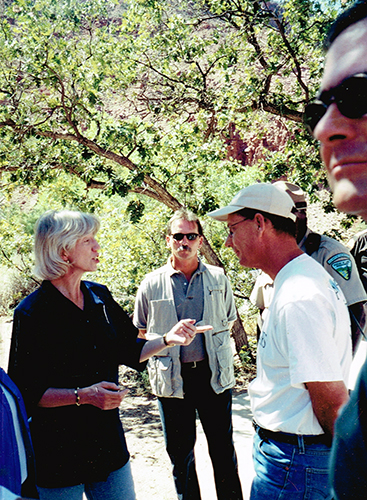
| ABOUT | ARTICLES | FORUM | RESOURCES | GALLERY | CROSS |
 |
|
|||||||||||||
|
||||||||||||||
|
Talk about this article... Post-2026 EIS: Scoping for Reconsultation of Interim Guidelines March 06, 2024  Gale Norton and John Weisheit along the Colorado River in 2004 discussing the potential option to improve critical habitat, water delivery and water quality by decommissioning Glen Canyon Dam. WEBSITES: Department oif Interior
__________________________________________ ALTERNATIVES FROM THE STATES, MAJOR NGOS, AND ACADEMICSNew information for Post-2026 EIS
The take of climate change
NEWS
NOTE: The Draft EIS is scheduled to be published at the end of Year 2024. SCOPING REPORT is provided HERE DISCUSSION: Deep Uncertainty We think the future is easy to determine, but the necessary sacrifices to prepare for this future are not achievable, because our society is deeply disconnected from Nature. We find it difficult to accept this truth: Nature as baseline.
NEWS about Deep Uncertainty
National Academy of Sciences on deep uncertainty
The naturalist approach
DOING THE MATH WITH PENCIL AND PAPER
NEWS
COMMENT LETTERS FOR POST-2026 OPERATIONS EIS
SCOPING COMMENTS COMPILED BY BUREAU OF RECLAMATION
### COMMENTS ARE DUE: Tuesday, August 15, 2023 (60 days) Send comments to: eMall address: crbpost2026@usbr.gov Or. via postal service to: Bureau of Reclamation More information will be provided at a later time. Please return. ###
ALTERNATIVES
WE THINK THIS IS HELPFUL INFORMATION: Opinions by the Federal Appellate Court in the 10th District; July of 2023. NEPA litigation for the Green River Block Water Exchange Contract between Reclamation and the state of Utah; a new depletion contract for water stored in Flaming Gorge Reservoir.
### NEWS
### NARRATIVE During the public scoping meetings for the development of 2007 Interim Guidelines, the water managers in attendance were emphatic; that reductions greater than 20% would be "impossible" to achieve. This is why the seven states did not participate in the voluntary prescriptions of the original Guidelines, until reservoir elevations approached the level where intakes at Glen Canyon Dam begin to suck air. Precautionary planning in the Colorado River Basin was possible in 1970 when Long Range Operating Criteria (LROC) became the first tool to achieve water resource sustainibilty, and precautionary planning right now is a situation of too little and too late. Because this economic engine is designed for consumptive uses of 16.5 million acre-feet annualy, not 12.5 maf (a reduction of minus 25%). Consequently, the decision-makers have to understand that this ship has already slammed into an iceberg. We will eventually understand that the best solution is to begin conversations about starting over. Read: Revelle and Wagoneer, 1983 The proposed reductions from the Lower Basin States, as of this date, is about 12% per year. The ask from Reclamation was a range from 14% to 27%. Additionally, it would appear that the Upper Basin states will not be participating in any reductions at this time. The Upper Basin states are building and enlarging dams at the present time, and other diversion contracts have been proposed. Consequently, the grassroots have intervened by engaging the judicial branch of governement. At the end of the next decade, reductions of 30% will be necessary; and then 40% in the following decades thereafter. Especially if the municipalities continue to sprawl across the deserts of North America, and fueling that growth by purchasing water from farmers that take the responsibility of feeding the nation very seriously. Proposed new sources of water, such as constructing desalination facilities, and the electric generating stations that will power them, and the pipelines, and the pump stations, and the transmission wires, will not be operational in the 2030s, nor in the 2040s. So these are the decades when the system will crash and the assets of 50 to 60 million people become stranded. If your thinking otherwise, consider that it took parts of four decades to negotiate the Law of the River, and to finish the construction of Hoover Dam, the All American Canal, and the Colorado River Aqueduct. We can anticipate the depletion of our groundwater supplies as the third and final bad planning decision, and witness the great abandonment of this geography. Rather than kicking a rusty can in the wrong direction, let's stop this madness and take a completely different pathway.
### COMPARING THE PROCESS OF 2005 WITH THE PROCESS OF 2022 Federal Register Notices of 2023 and from 2005
### TERMINATION DATES OF 2007 INTERIM GUIDELINES Termination date of 2007 Guidelines
Termination dates of "Special Provisions"
Talk about this article... |
| ||||